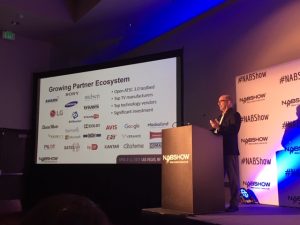
After more than 40 years of operation, DTVE is closing its doors and our website will no longer be updated daily. Thank you for all of your support.
NAB Show attendees get Phoenix ATSC 3.0 trial update
 Work towards implementing the new US advanced TV standard, ATSC 3.0, has made some progress over the last year, with NAB Show attendees yesterday hearing about trials in Phoenix, Arizona, Cleveland, Ohio and Chicago, Illinois.
Work towards implementing the new US advanced TV standard, ATSC 3.0, has made some progress over the last year, with NAB Show attendees yesterday hearing about trials in Phoenix, Arizona, Cleveland, Ohio and Chicago, Illinois.
Peter Van Peenen, a consultant to channel group Pearl TV, provided an update on a key trial in Phoenix, Arizona that kicked off one year ago.
Van Peenen told NAB Show attendees that the trial had involved 12 Phoenix TV stations, including all Pearl stations in the area. The trial had encompassed elements such as integration with cable distributors, content protection, data-gathering and commercialisation opportunities such as addressable advertising and automotive distribution.
Van Peenen said the trial had been complex to set up, requiring agreements on spectrum to get stations up and running while making sure that all transmissions were coordinated.
He said that creating ATSC 3.0 service launch profiles had also required close work with OEMs. One of the issues, he said, was that manufacturers had “wanted us to narrow down [the specifications] and take out what we didn’t want to use at launch”.
Van Peenen said that setting up the trial had partly been “a matter of negotiation because we didn’t want to make it too hard for receiver manufacturers” to participate.
Van Peenen said that the trial had started with the creation of some prototype receivers and signal protection tests, followed in Q3-Q4 by build phase. He said that the trial was currently at the consumer test phase.
Van Peenen said that lessons learned so far from the trial included that MPEG DASH timeline media segments are recommended for content replacement and that use of the Common media Application Format (CMAF) is recommended for content replacement and to improve channel change times.
He said that there had been a strongly positive consumer reaction to advanced audio features enabled by Dolby AC-4 audio.


